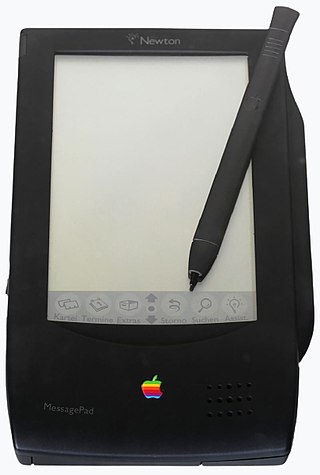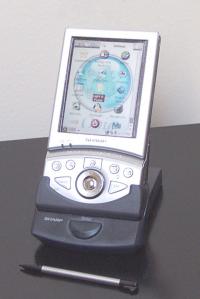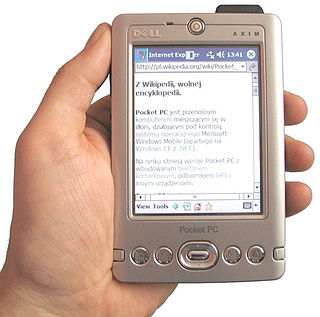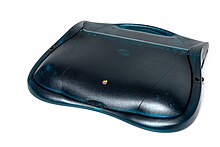
The MessagePad was a series of personal digital assistant devices developed by Apple Computer for the Newton platform in 1993. Some electronic engineering and the manufacture of Apple's MessagePad devices was undertaken in Japan by Sharp. The devices are based on the ARM 610 RISC processor and all featured handwriting recognition software and were developed and marketed by Apple. The devices run Newton OS.

A motherboard is the main printed circuit board (PCB) in general-purpose computers and other expandable systems. It holds and allows communication between many of the crucial electronic components of a system, such as the central processing unit (CPU) and memory, and provides connectors for other peripherals. Unlike a backplane, a motherboard usually contains significant sub-systems, such as the central processor, the chipset's input/output and memory controllers, interface connectors, and other components integrated for general use.

The Tandy 1000 is the first in a line of IBM PC compatible home computer systems produced by the Tandy Corporation for sale in its Radio Shack and Radio Shack Computer Center chains of stores. Introduced in 1984, the product line was aimed at providing affordable but capable systems for home computing or education, with some of its Tandy specific features like graphics, sound and joystick port making it more appealing for home use.

The Apple IIe is the third model in the Apple II series of personal computers produced by Apple Computer. It was released as the successor to the Apple II Plus. The e in the name stands for enhanced, referring to the fact that several popular features were now built-in that were formerly only available as upgrades or add-ons in earlier models. It is notable as the first Apple II to offer built-in lower-case and 80 columns text support, as well a full 64K RAM–all while reducing the total chip count from previous models by approximately 75%.

The Sharp Zaurus is the name of a series of personal digital assistants (PDAs) made by Sharp Corporation. The Zaurus was the most popular PDA during the 1990s in Japan and was based on a proprietary operating system. The first Sharp PDA to use the Linux operating system was the SL-5000D, running the Qtopia-based Embedix Plus. The Linux Documentation Project considers the Zaurus series to be "true Linux PDAs" because their manufacturers install Linux-based operating systems on them by default. The name derives from the common suffix applied to the names of dinosaurs.

The Apple IIc is a personal computer that was introduced by Apple Inc. shortly after the launch of the original Macintosh. It was a compact and portable version of the Apple II series of computers. The IIc featured a built-in floppy disk drive and a keyboard, and was often sold with its matching monitor. The c in the name stood for compact, referring to the fact it was a complete Apple II computer setup with a floppy drive that was squeezed into a smaller notebook-sized housing. It was compatible with a wide range of software and peripherals.
Casio Cassiopeia was the brand name of a PDA manufactured by Casio. It used Windows CE as the Operating system. Casio was one of the first manufacturers of PDAs, developing at the beginning small pocket-sized computers with keyboards and grayscale displays and subsequently moving to smaller units in response to customer demand.

The PowerBook G3 is a series of laptop Macintosh personal computers designed, manufactured, and sold by Apple Computer from 1997 to 2001. It was the first laptop to use the PowerPC G3 (PPC740/750) series of microprocessors, and was marketed as the fastest laptop in the world for its entire production run. The PowerBook G3 was succeeded by the PowerBook G4.

The Macintosh Classic II is a personal computer designed and manufactured by Apple Computer, Inc. from October 1991 to September 1993. The system has a compact, appliance design with an integrated 9" monitor, typical of the earliest of the Macintosh range. A carrying handle moulded into the case added a degree of portability at a time when laptops were still relatively uncommon.

The Dell Axim family of personal digital assistants was Dell's line of Windows Mobile-powered Pocket PC Devices. The first model, the Axim X5, was introduced in 2002, while the final model, the Axim X51, was discontinued on April 9, 2007.
The O2 Xda brand was a range of Windows Mobile PDA phones, marketed by O2, developed by O2 Asia and manufactured by multiple OEMs (mainly HTC, Quanta and Arima). The first model was released in June 2002. The last models came to market in 2008. The "X" represents convergence of voice and information/data within one product; the "DA" stands for "Digital Assistant", as in PDA. The name of XDA Developers is derived from it.

The SIMpad is a portable computer developed by the company Keith & Koep by order of Siemens AG, with an 8.4" TFT touchscreen. Commonly used with wireless network cards, it was marketed as a device to browse the World Wide Web. Initially announced in January 2001 at the Consumer Electronics Show.

The Jornada was a line of personal digital assistants or PDAs manufactured by Hewlett-Packard. The Jornada was a broad product line that included Palm-Size PCs, Handheld PCs, and Pocket PCs. The first model was the 820, released in 1998, and the last was the 928 model in 2002 when Compaq and HP merged. The Jornada line was then succeeded by the more popular iPAQ model PDAs. All Jornada models ran Microsoft Operating Systems that were based on Windows CE.

The Macintosh Quadra 605 is a personal computer designed, manufactured, and sold by Apple Computer from October 1993 to July 1996. The model names reflect a decision made at Apple in 1993 to follow an emerging industry trend of naming product families for their target customers – Quadra for business, LC for education, and Performa for home. Accordingly, the Performa 475 and 476 was sold in department stores and electronics stores such as Circuit City, whereas the Quadra was purchased through an authorized Apple reseller.

The Power Macintosh 5500 is a personal computer designed, manufactured, and sold by Apple Computer from February 1997 to March 1998. Like the Power Macintosh 5260 and 5400 that preceded it, the 5500 is an all-in-one design, built around a PowerPC 603ev processor operating at 225, 250 or 275 megahertz (MHz).

The A7000 and A7000+ were Acorn Computers' entry level computers based somewhat on the Risc PC architecture.
HP X-Terminals are a line of X terminals from Hewlett Packard introduced in the early- to mid-1990s, including the 700/X and 700/RX, Envizex and Entria, and the Envizex II and Entria II. They were often sold alongside PA-RISC-based HP 9000 Unix systems. The primary use case was connecting several graphical consoles to a single server or workstation to allow multiple users access the same (expensive) processing system from terminal systems. These X-Terminals all allowed high-resolution, color-graphics access to the main server from which they downloaded their operating system and necessary program files. All models featured limited expandability, in most cases additional I/O options for peripherals and memory for more programs or local storage. HP did not use its own PA-RISC platform for these systems, the first design used an Intel CISC processor, while all later systems used RISC platforms, first Intel i960 and later the popular MIPS.

The PlayStation technical specifications describe the various components of the original PlayStation video game console.
The Clie NX, were a series of handheld PDAs made by Sony, their first running the Palm OS 5.0 operating system. They had a clam-shell form factor, with a vertical rotatable screen. Most of these models also had a rotatable camera built in.

The Palm Top PC 110 is a handheld personal computer that was developed jointly by IBM's Japanese subsidiary and Ricoh. It was released exclusively in Japan in September 1995. It used the Intel 80486SX microprocessor and was available in three different configurations. It used a Japanese keyboard, could be used in a docking station, and had a modem connection. During the development phase, the size was decreased. After the release, it was received positively for the number of features, but negatively for the small keyboard.


















